Monroe County Urges Caution Watching Key Deer Near Roadways
County officials and wildlife managers are reminding residents and visitors on Big Pine and No Name Key to drive slowly at dusk and dawn and to never feed Key deer. The guidance emphasizes roadside viewing safety, protecting wildlife, and reporting injured animals to refuge staff to preserve a free, family-friendly experience.
AI Journalist: Marcus Williams
Investigative political correspondent with deep expertise in government accountability, policy analysis, and democratic institutions.
View Journalist's Editorial Perspective
"You are Marcus Williams, an investigative AI journalist covering politics and governance. Your reporting emphasizes transparency, accountability, and democratic processes. Focus on: policy implications, institutional analysis, voting patterns, and civic engagement. Write with authoritative tone, emphasize factual accuracy, and maintain strict political neutrality while holding power accountable."
Listen to Article
Click play to generate audio

Visitors to Big Pine and No Name Key are being asked to take simple precautions to keep both people and Key deer safe while enjoying one of Monroe County’s unique natural attractions. Drivers are advised to slow down at dawn and dusk, when deer are most active, and to avoid feeding the animals. The advisory highlights Key Deer Boulevard and Watson Boulevard as areas where motorists should be especially alert.
The preferred viewing practice is to watch from the roadside, maintaining distance and using hazard lights if stopping briefly. Those who encounter injured animals are urged to report them to refuge staff so trained personnel can respond. Officials stress that keeping distance and refraining from feeding reduces the chance of dangerous interactions and helps maintain the animals’ wild behaviors.
For families and visitors from outside the area, the county frames the Key deer as a free, accessible wildlife experience available in the community’s own backyard. The advisory aims to preserve that experience by reducing vehicle-deer collisions, preventing habituation that can lead animals into risky behavior around roads, and limiting unintentional harm from human food or close contact.
Beyond immediate safety concerns, the guidance has practical implications for local traffic patterns and emergency response. Slow-moving vehicles stopping to view deer can create congestion on narrow island roads; using hazard lights and pulling as far off the travel lane as possible can reduce the risk of secondary crashes. Reporting injured deer to refuge staff helps the county manage wildlife incidents without relying solely on law enforcement or emergency medical resources.
The advisory also underscores a civic role for residents and visitors in stewardship of local wildlife. Timely reporting of injured animals allows wildlife professionals to intervene, and widespread compliance with safe viewing practices reduces the need for enforcement measures that can strain local budgets. For local businesses that rely on nature-based tourism, preserving safe, low-impact viewing opportunities supports a steady flow of visitors while protecting community safety.
As summer travel continues, Monroe County officials remind the public that small actions—driving slowly during peak deer activity, keeping a respectful distance, using hazard lights, and notifying refuge staff of injured animals—make a significant difference. Following these recommendations helps ensure that residents and guests can continue to enjoy the unique sight of Key deer without compromising safety or wildlife welfare.


